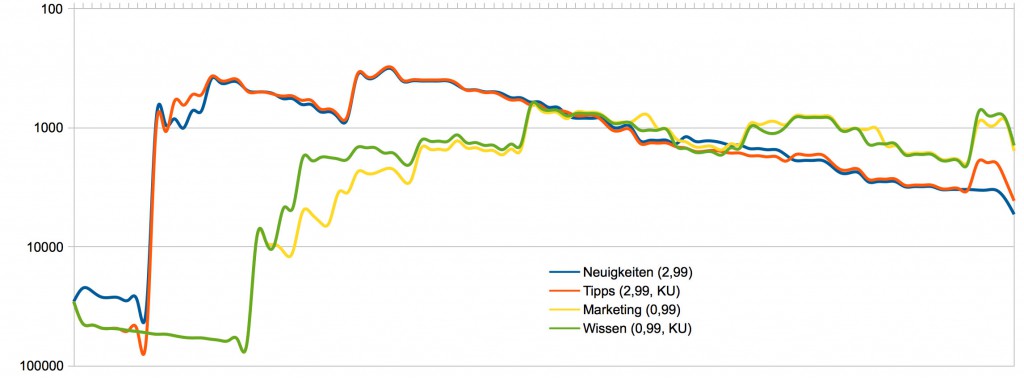The way Amazon calculates a sales rank for an ebook often seems mysterious. Does the price play a role in it, is it important to have a title enrolled in KDP Select? Nobody knows for sure, and I think even Amazon’s software engineers are not really sure about the whole process. Last week I called the readers of this blog to help in a large test, and about 90 of them responded.
To be able to actually prove or falsify a thesis, we need an experimental setup. The three primary theories to check were:
- Price influences sales rank
- Enrolling in KDP Select influences sales rank
- The dynamics of sales influence sales rank
To create a concise test environment, I uploaded four new ebooks, generated from different parts of the Selfpublisherbibel. All titles went into the same category. The test was carried out on Amazon.de but I’m sure the results are valid for other marketplaces too. These are the four test titles:
- “Wissen“: KDP Select yes, 0.99 Euro.
- “Neuigkeiten“: KDP Select no, 2.99 Euro.
- “Tipps“: KDP Select yes, 2.99 Euro.
- “Marketing“: KDP Select no, 0.99 Euro.
The experiment then went as follows:
- 25. 11., 17:30: all ebooks uploaded.
- 25.11., 19:45: all ebooks approved.
- 25.11., 19:45: bought all ebooks once.
- 26.11., 17:30: all titles have a sales rank.
- 27.11. 08:40: message to all testers describing what they had to do.
- 27.11., ca. 17 Uhr: 60 sales/borrows of “Tipps” and “Neuigkeiten”.
- 28.11., ca. 10 Uhr: 20 sales/borrows of “Wissen” and “Marketing”.
- 28.11., ca. 17 Uhr: 20 sales/borrows of “Wissen” and “Marketing”.
- 28.11., ca. 17 Uhr: 30 sales/borrows of “Tipps” and “Neuigkeiten”.
- 29.11., ca. 10 Uhr: 20 sales/borrows of “Wissen” and “Marketing”.
- 30.11., ca. 10 Uhr: 20 sales/borrows of “Wissen” and “Marketing”.
- 01.12., ca. 10 Uhr: 10 sales/borrows of “Wissen” and “Marketing”.
All titles were supposed to be bought resp. borrowed by 90 users. Kindle Unlimited users were asked to read at least upto 10 percent. The chart and the table below are showing the results.
Fact 1: Price does not influence sales rank.
Both 2.99 and 0.99 titles reached similar sales ranks with similar sales (see table).
Fact 2: Enrollment in KDP Select does not influence sales rank.
All titles are treated equal, whether they are enrolled in KDP Select or not.
Fact 3: Organic growth of sales number results in a higher ranking.
Yellow and green curves are based on less sales than red and blue curves but still reach higher rankings in the end.
Fact 4: Sales of (much) more than 24 hours are important for the sales rank.
One day without sales decreases the sales rank of a title in the same way as halving its sales numbers. That means the Amazon algorithms devalue a sale by half every 24 hours (approximately, they exact amount is impossible to calculate). Add to this that the sales numbers are increasing exponentially with high ranks and it gets clear how hard it is for a new title to climb into the charts.
A title with sales rank X gets counted by the algorithm with all its sales from today plus half its sales from yesterday plus a quarter of its sales from the day before yesterday plus… You get the idea. All these halfs and quarters add up to 1 so basically the title gets counted with double its actual sales numbers. That means a title with a lower rank (and less visibility) must reach at least twice the sales numbers of the higher ranked title to actually overtake it if it is brand new. This distance decreases from day to day because the newer, lower title also gets counted with its sales from yesterday etc.
This kind of dynamics explains strange phenomenons seen by many users. “My title 1 only sold x this day on rank y while my title 2 sold more on a lower rank”.
Fact 5: Borrows on KindleUnlimited influence the sales rank immediately.
I couldn’t believe this first. Borrows on KindleUnlimited are only paid when the user reads at least 10 percent. But for the sales rank all borrows count immediately. I saw a first hint of this in the chart above because the numbers for the KU titles are always leading in front of the Non-KU-Titles a bit. Therefore, I tested that with another title. The result was very clear: After four users borrowed it without ever opening, the title climbed from position 190,000 to 4,000. Sales, on the other hand, only count for the sales rank if they are in the sales report (being shown on the dashboard is not enough).
This clearly is a bonus to KindleUnlimited authors. You can reach higher visibility on Amazon without having to wait until a borrower actually reads your book. Even if a borrower never reads your book but only returns it later, you still have a higher sales rank (but you won’t get paid, of course).
Fact 5 also explains why there often is a difference between sales numbers and sales ranks as the author has no possibility to actually see these virtual borrows.
What does that mean for the author?
Be patient. If you are planning promotions, start with the least effective and increase their power in several steps. 20 sales each day for a week get you higher than 150 sales one day and none the other. KindleUnlimited is not as bad a deal as one might think – at least, you get an immediate boost if someone borrows your title.
(This is the shortened English version of this article)
[table id=44 /]

